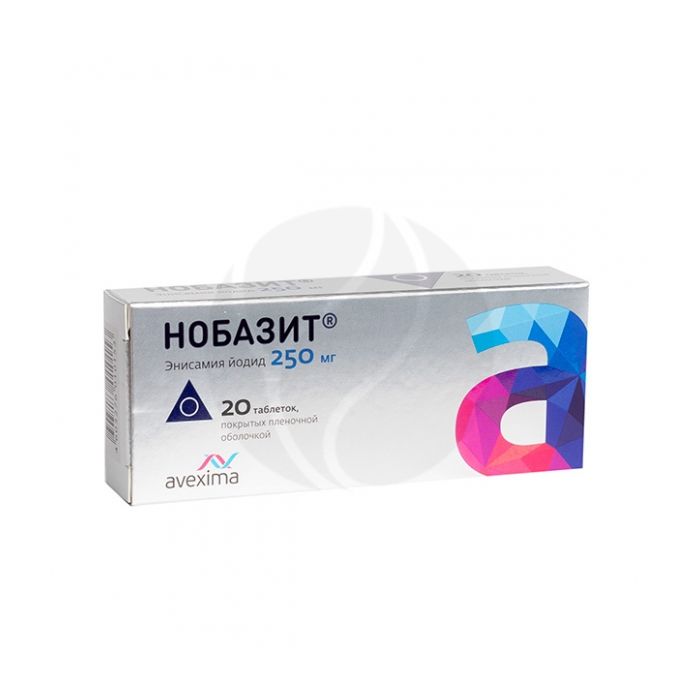Nobazit tablets 250mg, No. 20
Expiration Date: 05/2027
Russian Pharmacy name:
Нобазит таблетки 250мг, №20
NobazitЃ is taken orally after meals, without chewing, 0.5 g 3 times a day.
The maximum single dose is 1 g, the daily dose is 2 g. The recommended course of treatment is from 5 to 7 days.
Film-coated tablets, yellow, round, biconvex; on a cross section, the kernel is from light yellow to yellow or yellow with a greenish tinge.
1 tab.
enisamia iodide (in terms of 100% anhydrous substance)
Excipients: (core) lactose monohydrate (milk sugar), microcrystalline cellulose (Vivapur 101), sucrose (refined sugar), povidone (low molecular weight medical polyvinylpyrrolidone or Plasdon K-17), Copovidone (Plasdon S-630) (Polypovidone) XL-10), talc, calcium stearate.
An indication of a history of allergic reactions, regardless of the nature of the allergen;
severe organic damage to the liver and kidneys;
pregnancy;
lactation period (breastfeeding);
age under 18;
hypersensitivity to enisamia iodide.
pharmachologic effect
Antiviral agent derived from isonicotinic acid. Effectively suppresses the action of influenza viruses and other causative agents of acute respiratory viral infections (ARVI) due to the direct (inhibitory) effect on the process of penetration of viruses through the cell membrane.
It has interferonogenic properties, increases the concentration of endogenous interferon (interferon alpha and interferon gamma) in blood plasma by 3-4 times.
Increases the body's resistance to viral infections.
Reduces acute clinical manifestations of viral intoxication, helps to reduce the duration of the disease.
Pharmacokinetics
Suction
After ingestion, it quickly enters the bloodstream, Cmax in the blood is observed 2-2.5 hours after ingestion.
Metabolism and excretion
Enisamia iodide and its metabolites circulate for a long time in the bloodstream (T1 / 2 is 13.5-14 hours), are metabolized in the liver and are rapidly excreted from tissues (T1 / 2 is 2-3 hours). It is excreted by 90-95% in the urine in the form of metabolites.
Side effect
Allergic reactions: hypersensitivity reactions, including skin rashes, urticaria, angioedema, itching.
From the digestive system: dry and bitter taste in the mouth, swelling of the oral mucosa, hypersalivation, staining of the tongue yellow, nausea, vomiting, heartburn, abdominal pain, heaviness in the right hypochondrium, diarrhea, bloating.
From the respiratory system: shortness of breath, throat irritation.
In the post-registration period, in isolated cases, the following adverse reactions were noted: headache, dizziness, weakness, fluctuations in blood pressure.
Application during pregnancy and lactation
Use during pregnancy and lactation (breastfeeding) is contraindicated.
Application for violations of liver function
Not recommended for severe liver dysfunction.
Application for impaired renal function
Not recommended for severe renal impairment.
Application in children
Contraindicated for use in children and adolescents under the age of 18 years.
Use in elderly patients
There are no special instructions for limiting the application.
special instructions
It should be used with caution in patients with thyroid disease, especially with hyperthyroidism.
Drug interactions
Strengthens the action of antibacterial and immunomodulatory agents.
A combination with ascorbic acid and other vitamins is advisable.
Can be administered concurrently with recombinant interferon.

